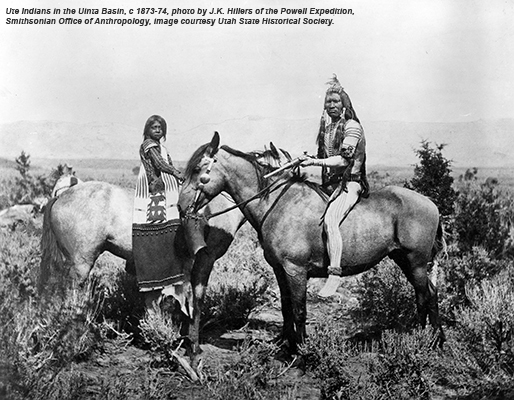Dublin Core
Title
Description
Learn about the forced relocation of Ute people from lush central Utah to the remote Uinta Basin.
In the mid-19th Century federal Indian policy shifted from Indian Removal toward the reservation system. The result for many Native groups, however, was effectively the same in that they were forcibly removed from familiar and productive homes to start new lives on isolated and often marginal lands.
In Utah, the Timpanogos Utes had lived for centuries in Utah Valley, relying upon the fisheries at the mouth of the Provo River. They viewed the initial Mormon settlements to the north as a trading opportunity, but as their new neighbors expanded, relations began to sour as they all competed for the same scarce resources. Mormon settlers moved into Utah Valley in 1849, setting off a series of increasingly violent conflicts, starting with the Walker War in 1853. As Mormon settlements grew, the Ute population of Utah Valley and Central Utah spiraled downward.
In 1861, a survey party reported that the Uinta Basin in eastern Utah was, “one vast contiguity of waste, and measurably valueless, except for nomadic purposes, hunting grounds for Indians, and to hold the world together.” Upon hearing that, Brigham Young scrapped plans to send Mormon settlers into the area and instead viewed it as the logical location for a Ute reservation. Shortly thereafter Abraham Lincoln created the Uintah Reservation by executive order.
Utes had always hunted and traversed the Uinta Basin, but its resources were meager compared to the Utah and Sanpete valleys. It was not until the Black Hawk War erupted in 1865 that time ran out. It was the longest and bloodiest of Utah’s Indian conflicts, and the Ute bands ultimately accepted the provisions of the Treaty of Spanish Fork and began their journey to the remote Uinta Basin.
A decade and a half later, their kinspeople, the White River and Uncompaghre Utes, were forced from their homes in Colorado and joined them on what became the Uintah and Ouray Reservation.
Creator
Greg Smoak for the American West Center at the University of Utah © 2015
Source
Image: Ute Indians: "The Warrior and his Bride". Ute Indians from the Uintah Valley, eastern slope of the Wasatch Moutains. Photo by JK Hillers of the Powell Expedition, 1873-1874. Courtesy of Utah State Historical Society.
_______________
See Gregory E. Smoak, Utah’s Journey Stories, Salt Lake City: Utah Humanities Council, 2014; Forrest Cuch, ed., A History of Utah’s American Indians, (Salt Lake City: Utah Division of Indian Affairs, 1996); Jared Farmer, On Zion’s Mount: Mormons, Indians, and the American Landscape, (Cambridge: Harvard University Press, 2010); Helen Z. Papanikolas, ed., The Peoples of Utah, (Salt Lake City: Utah State Historical Society, 1976); and David Rich Lewis, “Ute Indians,” Utah History Encyclopedia, accessed at Utah Division of State History’s History to Go website.
Publisher
The Beehive Archive is a production of Utah Humanities. Find sources and the whole collection of past episodes at www.utahhumanities.org
Date
2015-01-16

